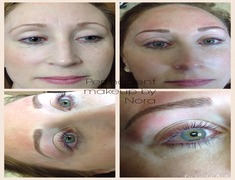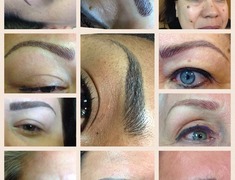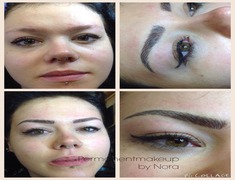FAQ
What are Permanent Cosmetics?
Permanent cosmetics describe non-surgical procedures that use specialized tattooing methods. Colored pigments are implanted into Dermis (middle layer) of the skin through microscopic injections with an extremely fine needle or cluster of needles. This process is also called Micropigmentation, Microdemal Pigmentation, Dermagraphics, Intradermal Cosmetics, Dermal Implantation, or Micropigment Implantation. Permanent Makeup is the term used to describe the cosmetic tattooing of facial features (eyebrows, eyelids, or lips) to improve color and shape.
What are Medical or Paramedicl Permanent Cosmetics?
This is a highly specialized and advanced area of permanent cosmetics that focuses on people with medically-related condition. Examples include surgical scars (e.g. breast reconstruction, hair transplant), trauma scars (e.g. accidents or burns), or unnatural skin conditions (e.g. Vertigo Alpeda). The techniques restore color and symmetry to an affected area(s). The results can help a person look better and improve his or her self-esteem. This process is also called Medical tattooing, Paramedical Tattooing, Corrective Tattooing, Reconstructive Tattooing, or Restorative Tattooing.
Are Permanent Cosmetics Safe?
According to the Centers for Disease Control (CDC), permanent cosmetics are safe when the technician is educated in the control of Blood Borne Pathogens and follows all OSHA (Occupational Safety and Health Administration) guidelines. However, permanent cosmetics are not licensed or regulated in most states including California. In those states, the best assurance of safety is a permit issued by the county health department. A permit is issued only when the tattooist, business, and equipment are examined and approved by a health department inspector. In California, about half of the cities in Orange and Los Angeles Counties are “regulated cities” where Inspections occur. In “no regulated” cities, there are no Inspections of anyone doing permanent cosmetics so the public is “on their own.”
Can I remove or change my permanent Makeup?
The removal of permanent makeup is not an easy process, if at all possible. That is why it is important to select a qualified and experienced professional who has a conservative approach. During the initial application, a “less is more” philosophy works best. A lighter, more natural color can always be changes or supplemented later with conventional makeup. It can also be adjusted or darkened if necessary with another application at a second (touch-up) appointment. Shape can also be refine at a follow up visit, but not drastically, so a good original design is a must.
Is a Cosmetic Tattooing procedure painful?
Due to the invasiveness of the process, some people may feel minor discomfort that varies according to their pain threshold and response to anesthetics. People describe what they feel in different ways such as “irritation”, “scratching”, “vibration”, or “a slight burning sensation.” Dr. Reed uses top grade topical anesthetic creams and gels before and during all procedures to numb the area and minimize discomfort. Most of her patients remark that their procedure was “far more comfortable than I thought it would be.” Those with body art comment that the cosmetic tattooing is painless compared to traditional tattooing. Overall, people feel the benefits from the results far outweigh any brief discomfort they might have experienced during the process.
Are the pigments that are used safe?
Permanent cosmetics utilize sterile pigments with cosmetic grade colorants that are approved by the FDA as safe for human use. Technically, the colored pigments used are suspensions containing insoluble inert compounds, usually iron or titanium oxides. The microscopic particles that appear to be dissolved are actually suspended in a clear liquid base of alcohol, distilled water, and glycerin. The traditional body tattooing process is different because it uses colored “inks” or “dyes” that are completely dissolved liquids with transparent color.
Are people allergic to the colored pigments?
Most of the pigments used for cosmetic tattooing are made to be hypo-allergenic. Studies have shown that acute (“Immediate”) allergic reactions to these products are extremely rare. Delayed hypersensitivity reactions (“delayed onset”) allergic reactions are also uncommon. Medical professionals believe that most “allergic reactions” are not reactions to the pigments. They believe a reaction is caused by a bacterial infection or an allergic reaction to a topical after care product. In 2004, the FDA recalled one pigment line by one manufacturer when allergic reactions occurred. The cause was determined to be a new preservative added to the formula. No other product recalls have occurred before or after that one.
What will the final color look like?
Permanent makeup colors should be selected to compliment a person’s skin tone, hair, and eye color. A conservative approach is best because it is easier to make an existing color darker versus lighter. Colors will always look darker and more intense immediately following a procedure, and then gradually lighten and soften upon healing. For medical tattooing (e.g. scar camouflage or areola re-pigmentation), color spot testing is advised to determine the best custom combination of colors for the tattooed area. All reputable permanent cosmetic professionals will record the pigment(s) used for a client in his or her file for future reference.
What is the recovery period like?
Immediately following a procedure, there will be mild swelling, redness, or tenderness that lasts a few hours to a few days (eyebrows swell less than eyes and lips). There may also be slight bruising with lip procedures. The color looks much darker immediately afterward for any procedure. It will lighten a lot within 3 to 7 days and will continue to lighten over several weeks. During the first week ointments must be applied to the tattooed area for protection and to minimize scabbing. Most people are amazed at how “normal” they look immediately after and do not feel it is necessary to take time off of work.
How long does each procedure take?
Many important steps are followed when a procedure is done correctly. A well- trained and permanent cosmetics specialist will take a minimum of 2 hours or more for initial appointment. It should include a consultation (if not done before) and a review of the person’s medical history. Time is then used to determine the best design, color selection, numbing, the actual procedure, photos, after care instructions, and answering all questions. Follow-up visits usually require less time. For scar camouflage work, spot testing for color accuracy must be completed first at least 6 weeks before the actual tattooing procedure.
Will Permanent Makeup continue to look good as I age?
It is true that as we age, our skin and its elasticity changes. However, there are many older women who look good wearing conventional makeup as long as it is correctly applied. Those women would look just as good with correctly applied permanent makeup. The best looking permanent makeup can be altered, however, if any facial surgery is performed that changes the position of the tattooed area. For example, if a brow lift is performed after a permanent eyebrow procedure, the eyebrows could be raised and look different. Therefore, anyone planning to have facial plastic surgery should discuss this with her surgeon and permanent cosmetic specialist.
Can I have an MRI procedure after cosmetic tattooing?
Yes. Magnetic Resonance Imaging (MRI) uses radio waves and electromagnetic fields to create pictures of internal human organs. The magnetism and temperature changes during these procedures may cause mild temporary discomfort in tattoos containing large amounts of iron oxide metals. Studies showed that only a few patients with an iron oxide tattoo reported a mild pulling or burning sensation during an MRI test. Most people with tattoos have had no problems. The size of the tattoo and the total number of tattoos seems to affect the magnetic pull. According to MRI safety experts, the iron particles in most cosmetic tattooing pigments are too microscopic to react as metal pieces. However, they recommend that a patient with a tattoo informs the radiologist and technician where it is located because it may create a small artificial image (artifact).
Can someone donate blood after a procedure?
Yes. However, it is the policy of the American Red Cross that anyone who has had a cosmetic tattooing procedure must wait one year before donating blood or platelets.
Is a Cosmetic Tattooing procedure expensive?
Permanent cosmetics are affordable for most people and the long term benefits make procedures fairly inexpensive. Other non-surgical procedures like Botox or fillers cost the same or more. But they may only last three to twelve months while cosmetic tattooing lasts for years. The savings from not having to buy regular makeup products that are applied every day adds up quickly. Also, the convenience and time saved from not applying makeup every day are worth a lot, and the self-esteem that is restored by permanent makeup is priceless.


